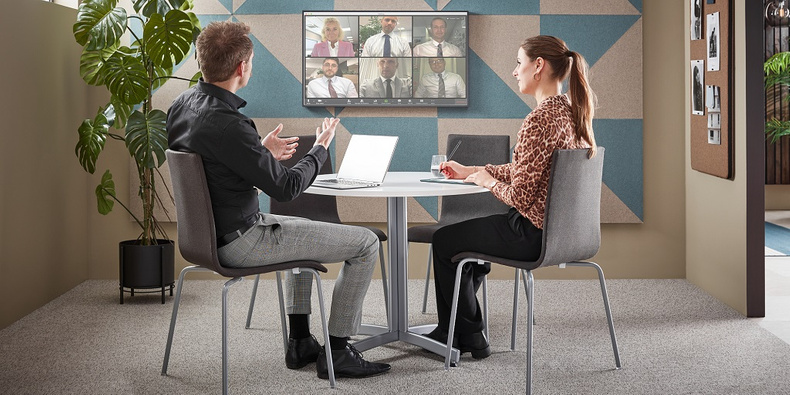How to adapt your office space to suit new post-pandemic working patterns

As part of a Return to Work series, AJ Products looks at the ways in which the Covid-19 pandemic may leave a lasting impression on the way we work and how offices can adapt to provide productive workspaces where staff will thrive in the new normal.
In March 2020 at the start of the first lockdown, working from home was unknown territory to most people, an occasional luxury to others. A year on, many office-based businesses have learnt that they can operate effectively with remote staff. To capitalise on the success of remote working, many companies are planning to embrace a combination of remote and on-site working, giving rise to a hybrid work model. As a result, some companies are downsizing their offices or even giving up their office space altogether. The concept will cut overhead costs for businesses and give employees more flexibility over the way they work.
AJ Products asks the question: how can businesses optimise their reduced office space to suit this new hybrid model in the long term?
How can you optimise your remaining office space?
Hot desks and flexible working areas
Hot desks are an effective way to reduce office space when you don't expect the full workforce to be in the office at the same time. A hot desk policy means that instead of each member of staff having an allocated desk, workstations are open for use by anybody as and when needed. In addition to this, consider having other flexible workspaces such as breakout areas with a mix of furniture including sofas, long tables with benches, and bar tables and chairs, which will allow staff to work in a way that suits them and their tasks. (In the immediate term while some Covid restrictions are still in place, measures will need to be taken to make sure these workspaces are safe and sanitary. Daily cleaning will be essential.)
Collaborative spaces
If staff are working only part-time in the office, then in-person meetings and team projects should be prioritised on those days, with individual tasks left for remote working days. In order to encourage and facilitate this, the office could be redesigned to get rid of cubicles and individual workspaces and instead create more collaborative meeting spaces. This doesn't have to mean conference rooms. In fact, casual meeting spaces that offer plenty of flexibility are often more effective as they can be adapted to current needs and allow for a more relaxed and creative atmosphere.
Try to provide a variety of different collaborative spaces throughout the office. Choose office furniture that is easy to move around and provide several different seating options so employees can reconfigure the space to suit their purpose. An effective collaboration area will strike a balance between comfort and practicality. Think about connectivity: having fast WiFi and plenty of accessible power outlets is essential so that employees can charge their laptops and mobile devices while they work.
Lockers and personal storage
Without allocated desk spaces, lockable personal storage on-site will be essential to allow staff to store their belongings safely along with any IT equipment or paperwork that they don't want to take back and forth from home to the office with them. Smart personal storage lockers can be both a practical and stylish addition to the office space. Think about the needs of your employees. Do you just want them to be able to store the contents of their desk overnight? If they won't have a desk space during the day, should they be able to fit their bag in the locker too? Should some lockers be big enough to fit a bike helmet or gym kit? Depending on how you will allocate lockers, different types of locks are available so decide in advance whether each member of staff will have their own locker or if lockers will be allocated per day (like in the gym).
Quiet zones for virtual meetings
Even as people return to the office and are able to arrange in-person meetings with colleagues, virtual meetings will continue to play a significant role. This year has taught companies that global business travel is less essential than it once appeared and that video conference calls can replace a lot of the meetings that employees would previously have been asked to travel to attend. It will be important to accommodate these meetings in the office by providing quiet zones with good acoustics where employees can speak without disturbing their colleagues and where background noise will not feed back and affect their ability to hear and talk in the meeting. This may include adding acoustic meeting booths, huddle rooms or soundproof pods to your open office space.
Adapting the office environment will allow businesses to reduce their overall office space while ensuring that the remaining space is better suited to new ways of working and boosts staff productivity. AJ Products will look into other aspects of the hybrid work model and how businesses can support employee wellbeing as we continue our Return to Work series.
Laura Supple
AJ Products
